Recent Developments in Thermoelectric Generation: A Review
Abstract
1. Introduction
2. Theoretical Framework
2.1. Overview of Thermoelectric Generators
2.2. The Onsager Relationships
2.3. The Seebeck Effect
2.4. The Peltier Effect
2.5. The Thomson Effect
3. Applications of Thermoelectric Generators
4. Materials in TEG Performance
- Traditional TE materials: including Bi2Ti3-based alloy for low-temperature applications, PbTe for mid-to-high temperatures, and SiGe alloys for higher temperatures (up to 1275 K).
- Major materials except the traditional: skutterudites materials (CoSb3 alloy—their structure is composed of eight corner-shared CoSb6 octahedrons), Mg2Si, higher manganese silicides (HMS), half-Heusler compounds (intermetallic MNiSn and MCoSb where M could be Ti, Zr or Hf), and Zintl compounds (metals with a larger difference in electronegativity).
- Sulfides and selenides: SnX where X could be Se or S; Cu2X where X could be Se or S; and Cu12Sb4S13 tetrahedrite.
5. Mathematical Models of TEG Devices
6. TEG Systems under Mismatching Conditions
7. Conclusions
Funding
Institutional Review Board Statement
Informed Consent Statement
Acknowledgments
Conflicts of Interest
References
- UNFCC (United Nations Framework Convention on Climate Change). Paris Agreement; UNFCCC: Bonn, Germany, 2015; p. 29. (In Spanish) [Google Scholar]
- Morini, M.; Pinelli, M.; Spina, P.R.; Venturini, M. Optimal allocation of thermal, electric and cooling loads among gener-ation technologies in household applications. Appl. Energy 2013, 112, 205–214. [Google Scholar] [CrossRef]
- Du, W.-J.; Yin, Q.; Cheng, L. Experiments on novel heat recovery systems on rotary kilns. Appl. Therm. Eng. 2018, 139, 535–541. [Google Scholar] [CrossRef]
- Haddad, C.; Périlhon, C.; Danlos, A.; François, M.-X.; Descombes, G. Some Efficient Solutions to Recover Low and Medium Waste Heat: Competitiveness of the Thermoacoustic Technology. Energy Procedia 2014, 50, 1056–1069. [Google Scholar] [CrossRef]
- Montecucco, A.; Buckle, J.R.; Knox, A.R. Solution to the 1-D unsteady heat conduction equation with in-ternal Joule heat generation for thermoelectric devices. Appl. Therm. Eng. 2012, 35, 177–184. [Google Scholar] [CrossRef]
- Wang, X.D.; Huang, Y.X.; Cheng, C.H.; Lin, D.T.; Kang, C.H. A three-dimensional numerical modeling of ther-moelectric device with consideration of coupling of temperature field and electric potential field. Energy 2012, 47, 488–497. [Google Scholar] [CrossRef]
- Enn Velmre, Thomas Johann Seebeck (1770–1831). Est. J. Eng. 2007, 13, 276–282.
- Stockolm, J. Générateurs Thermo-Électriques. Journées Electrotechniques du Club EEA. 2003, pp. 15–21. Available online: https://www.researchgate.net/publication/228925386_GENERATION_THERMOELECTRIQUE (accessed on 15 November 2022).
- Elsheikh, M.H.; Shnawah, D.A.; Sabri, M.F.M.; Said, S.B.M.; Hassan, M.H.; Bashir, M.B.A.; Mohamad, M. A review on thermoelectric renewable energy: Principle parameters that affect their performance. Renew. Sustain. Energy Rev. 2014, 30, 337–355. [Google Scholar] [CrossRef]
- Söylemez, E.; Alpman, E.; Onat, A. Experimental analysis of hybrid household refrigerators including thermoelectric and vapour compression cooling systems. Int. J. Refrig. 2018, 95, 93–107. [Google Scholar] [CrossRef]
- Wang, Y.; Zhang, H.; Hao, H.; Li, H. Performance assessment and parametric study of a hybrid system consisting of an alkali metal thermoelectric converter and an absorption refrigerator. Energy Convers. Manag. 2019, 188, 346–353. [Google Scholar] [CrossRef]
- Zheng, X.; Liu, C.; Yan, Y.; Wang, Q. A review of thermoelectrics research—Recent developments and potentials for sustainable and renewable energy applications. Renew. Sustain. Energy Rev. 2014, 32, 486–503. [Google Scholar] [CrossRef]
- Champier, D. Thermoelectric generators: A review of applications. Energy Convers. Manag. 2017, 140, 167–181. [Google Scholar] [CrossRef]
- Onsager, L. Irreversible Processes. Phys. Rev. 1931, 37–38, 183–196. [Google Scholar]
- Kirschner, I.; Molnár, P. Relation between Curie’s principle and Onsager’s reciprocity. Acta Phys. Hung. 1989, 66, 277–287. [Google Scholar] [CrossRef]
- Beretta, D.; Neophytou, N.; Hodges, J.M.; Kanatzidis, M.G.; Narducci, D.; Martin-Gonzalez, M.; Beekman, M.; Balke, B.; Cerretti, G.; Tremel, W.; et al. Thermoelectrics: From history, a window to the future. Mater. Sci. Eng. R Rep. 2019, 138, 100501. [Google Scholar] [CrossRef]
- Munera, F. Desarrollo de un Modelo Matemático Fenomenológico que Permita Simular el Comportamiento de Sistemas Termoeléctricos. 2012, p. 98. Available online: https://repositorio.unal.edu.co/handle/unal/11246?show=full (accessed on 15 November 2022).
- Zhang, M.; Tian, Y.; Xie, H.; Wu, Z.; Wang, Y. Influence of Thomson effect on the thermoelectric generator. Int. J. Heat Mass Transf. 2019, 137, 1183–1190. [Google Scholar] [CrossRef]
- Kaushik, S.C.; Manikandan, S. The influence of Thomson effect in the energy and exergy efficiency of an annular ther-moelectric generator. Energy Convers. Manag. 2015, 103, 200–207. [Google Scholar] [CrossRef]
- Lamba, R.; Kaushik, S. Thermodynamic analysis of thermoelectric generator including influence of Thomson effect and leg geometry configuration. Energy Convers. Manag. 2017, 144, 388–398. [Google Scholar] [CrossRef]
- Tedeschi, S.; Mehnen, J.; Tapoglou, N.; Roy, R. Secure IoT Devices for the Maintenance of Machine Tools. Procedia CIRP 2016, 59, 150–155. [Google Scholar] [CrossRef]
- Cataldo, R.L.; Bennett, G.L. U.S. Space Radioisotope Power Systems and Applications: Past, Present and Future. 2011. Available online: https://ntrs.nasa.gov/citations/20120000731 (accessed on 15 November 2022).
- Shi, L.; Shu, G.; Tian, H.; Deng, S. A review of modified Organic Rankine cycles (ORCs) for internal combustion engine waste heat recovery (ICE-WHR). Renew. Sustain. Energy Rev. 2018, 92, 95–110. [Google Scholar] [CrossRef]
- Shu, G.; Yu, Z.; Tian, H.; Liu, P.; Xu, Z. Potential of the transcritical Rankine cycle using CO2-based binary zeotropic mixtures for engine’s waste heat recovery. Energy Convers. Manag. 2018, 174, 668–685. [Google Scholar] [CrossRef]
- Zhi, L.-H.; Hu, P.; Chen, L.-X.; Zhao, G. Parametric analysis and optimization of transcritical-subcritical dual-loop organic Rankine cycle using zeotropic mixtures for engine waste heat recovery. Energy Convers. Manag. 2019, 195, 770–787. [Google Scholar] [CrossRef]
- Ramírez, R.; Gutiérrez, A.S.; Eras, J.J.C.; Valencia, K.; Hernández, B.; Forero, J.D. Evaluation of the energy recovery potential of thermoelectric generators in diesel engines. J. Clean. Prod. 2019, 241, 118412. [Google Scholar] [CrossRef]
- Khalil, H.; Hassan, H. Enhancement thermoelectric generators output power from heat recovery of chimneys by using flaps. J. Power Sources 2019, 443, 227266. [Google Scholar] [CrossRef]
- Aranguren, P.; Astrain, D.; Rodríguez, A.; Martínez, A. Experimental investigation of the applicability of a thermoelectric generator to recover waste heat from a combustion chamber. Appl. Energy 2015, 152, 121–130. [Google Scholar] [CrossRef]
- Luo, Q.; Li, P.; Cai, L.; Zhou, P.; Tang, D.; Zhai, P.; Zhang, Q. A Thermoelectric Waste-Heat-Recovery System for Portland Cement Rotary Kilns. J. Electron. Mater. 2015, 44, 1750–1762. [Google Scholar] [CrossRef]
- Kaibe, H.; Makino, K.; Kajihara, T.; Fujimoto, S.; Hachiuma, H. Thermoelectric generating system attached to a carburizing furnace at Komatsu Ltd. Awazu Plant. 2012, 1449, 524. [Google Scholar] [CrossRef]
- Kuroki, T.; Kabeya, K.; Makino, K.; Kajihara, T.; Kaibe, H.; Hachiuma, H.; Matsuno, H.; Fujibayashi, A. Thermoelectric Generation Using Waste Heat in Steel Works. J. Electron. Mater. 2014, 43, 2405–2410. [Google Scholar] [CrossRef]
- Kuroki, T.; Murai, R.; Makino, K.; Nagano, K.; Kajihara, T.; Kaibe, H.; Hachiuma, H.; Matsuno, H. Research and Development for Thermoelectric Generation Technology Using Waste Heat from Steelmaking Process. J. Electron. Mater. 2015, 44, 2151–2156. [Google Scholar] [CrossRef]
- Kajihara, T.; Makino, K.; Lee, Y.H.; Kaibe, H.; Hachiuma, H. Study of Thermoelectric Generation Unit for Radiant Waste Heat. Mater. Today Proc. 2015, 2, 804–813. [Google Scholar] [CrossRef]
- Microplet. mva-002 @ www.micropelt.com. 2020. Available online: http://www.micropelt.com/en/products/mva-002.html (accessed on 15 November 2022).
- Perpetua, Getting Started|Perpetua Power Source Technologies, Inc. Available online: https://perpetuapower.com/getting-started/ (accessed on 14 June 2020).
- Kim, Y.J.; Gu, H.M.; Kim, C.S.; Choi, H.; Lee, G.; Kim, S.; Yi, K.K.; Lee, S.G.; Cho, B.J. High-performance self-powered wireless sensor node driven by a flexible thermoelectric generator. Energy 2018, 162, 526–533. [Google Scholar] [CrossRef]
- Milić, D.; Prijić, A.; Vračar, L.; Prijić, Z. Characterization of commercial thermoelectric modules for application in energy harvesting wireless sensor nodes. Appl. Therm. Eng. 2017, 121, 74–82. [Google Scholar] [CrossRef]
- Guan, M.; Wang, K.; Xu, D.; Liao, W.-H. Design and experimental investigation of a low-voltage thermoelectric energy harvesting system for wireless sensor nodes. Energy Convers. Manag. 2017, 138, 30–37. [Google Scholar] [CrossRef]
- Karthikeyan, V.; Surjadi, J.U.; Wong, J.C.; Kannan, V.; Lam, K.-H.; Chen, X.; Lu, Y.; Roy, V.A. Wearable and flexible thin film thermoelectric module for multi-scale energy harvesting. J. Power Sources 2019, 455, 227983. [Google Scholar] [CrossRef]
- Wang, Y.; Shi, Y.; Mei, D.; Chen, Z. Wearable thermoelectric generator for harvesting heat on the curved human wrist. Appl. Energy 2017, 205, 710–719. [Google Scholar] [CrossRef]
- Hyland, M.; Hunter, H.; Liu, J.; Veety, E.; Vashaee, D. Wearable thermoelectric generators for human body heat harvesting. Appl. Energy 2016, 182, 518–524. [Google Scholar] [CrossRef]
- Cao, J.; Querales, J.; Fahy, S.; Savić, I. Thermally induced band gap increase and high thermoelectric figure of merit of n-type PbTe. Mater. Today Phys. 2019, 12, 100172. [Google Scholar] [CrossRef]
- Wu, Y.; Zhang, H.; Zuo, L. Thermoelectric energy harvesting for the gas turbine sensing and monitoring system. Energy Convers. Manag. 2018, 157, 215–223. [Google Scholar] [CrossRef]
- Janak, L.; Ancik, Z.; Vetiska, J.; Hadas, Z. Thermoelectric Generator Based on MEMS Module as an Electric Power Backup in Aerospace Applications. Mater. Today Proc. 2015, 2, 865–870. [Google Scholar] [CrossRef]
- Kousksou, T.; Bédécarrats, J.P.; Champier, D.; Pignolet, P.; Brillet, C. Numerical study of thermoelectric power generation for an helicopter conical nozzle. J. Power Sources 2011, 196, 4026–4032. [Google Scholar] [CrossRef]
- Kristiansen, N.R.; Nielsen, H.K. Potential for Usage of Thermoelectric Generators on Ships. J. Electron. Mater. 2010, 39, 1746–1749. [Google Scholar] [CrossRef]
- Kristiansen, N.R.; Snyder, J.; Nielsen, H.K.; Rosendahl, L. Waste Heat Recovery from a Marine Waste Incinerator Using a Thermoelectric Generator. J. Electron. Mater. 2012, 41, 1024–1029. [Google Scholar] [CrossRef]
- Eddine, A.N.; Chalet, D.; Faure, X.; Aixala, L.; Chessé, P. Optimization and characterization of a thermoelectric gen-erator prototype for marine engine application. Energy 2018, 143, 682–695. [Google Scholar] [CrossRef]
- Zhu, W.; Huang, Z.; Chu, M.; Li, S.; Zhang, Y.; Ao, W.; Wang, R.; Luo, J.; Liu, F.; Xiao, Y.; et al. Enhanced thermoelectric performance through optimizing structure of anionic framework in AgCuTe-based materials. Chem. Eng. J. 2020, 386, 123917. [Google Scholar] [CrossRef]
- Li, G.; He, J.; An, Q.; Morozov, S.; Hao, S.; Zhai, P.; Zhang, Q.; Goddard, W.A.; Snyder, G.J. Dramatically reduced lattice thermal conductivity of Mg2Si thermoelectric material from nanotwinning. Acta Mater. 2019, 169, 9–14. [Google Scholar] [CrossRef]
- Qin, D.; Cui, B.; Meng, X.; Qin, P.; Xie, L.; Zhang, Q.; Liu, W.; Cao, J.; Cai, W.; Sui, J. High thermoelectric performance from high carrier mobility and reduced lattice thermal conductivity in Ba, Yb double-filled Skutterudites. Mater. Today Phys. 2019, 8, 128–137. [Google Scholar] [CrossRef]
- Hori, T. Role of geometry and surface roughness in reducing phonon mean free path and lattice thermal conductivity of modulated nanowires. Int. J. Heat Mass Transf. 2020, 156, 119818. [Google Scholar] [CrossRef]
- Huang, L.; Guo, J.; Ge, Z.H.; Jiang, Y.; Feng, J. Significantly reduced lattice thermal conductivity and enhanced thermoe-lectric performance of In2O3 (ZnO)3 ceramics by Ga2O3 doping. J. Solid State Chem. 2020, 281, 121022. [Google Scholar] [CrossRef]
- Balandin, A.A.; Nika, D.L. Phononics in low-dimensional materials Phonons—Quanta of crystal lattice vibrations—Reveal themselves in all. Mater. Today 2012, 15, 266–275. [Google Scholar] [CrossRef]
- Rittiruam, M.; Yangthaisong, A.; Seetawan, T. Reduced lattice thermal conductivity of Ti-site substituted transition metals Ti1-XTMXNiSn: A quasi-harmonic Debye model study. Chin. J. Phys. 2018, 57, 393–402. [Google Scholar] [CrossRef]
- Zhang, Z.; Hu, S.; Nakayama, T.; Chen, J.; Li, B. Reducing lattice thermal conductivity in schwarzites via engineering the hybridized phonon modes. Carbon 2018, 139, 289–298. [Google Scholar] [CrossRef]
- Crane, D.T.; Jackson, G.S. Optimization of cross flow heat exchangers for thermoelectric waste heat recovery. Energy Convers. Manag. 2004, 45, 1565–1582. [Google Scholar] [CrossRef]
- Chen, J.; Wu, C. Analysis on the Performance of a Thermoelectric Generator. J. Energy Resour. Technol. 1999, 122, 61–63. [Google Scholar] [CrossRef]
- Culebras, M.; Igual-Muñoz, A.M.; Rodríguez-Fernández, C.; Gómez-Gómez, M.I.; Gómez, C.; Cantarero, A. Manufacturing Te/PEDOT Films for Thermoelectric Applications. ACS Appl. Mater. Interfaces 2017, 9, 20826–20832. [Google Scholar] [CrossRef] [PubMed]
- Sabarinathan, M.; Omprakash, M.; Harish, S.; Navaneethan, M.; Archana, J.; Ponnusamy, S.; Ikeda, H.; Takeuchi, T.; Muthamizhchelvan, C.; Hayakawa, Y. Enhancement of power factor by energy filtering effect in hierarchical BiSbTe3 nanostructures for thermoelectric applications. Appl. Surf. Sci. 2017, 418, 246–251. [Google Scholar] [CrossRef]
- Ai, X.; Hou, D.; Liu, X.; Gu, S.; Wang, L.; Jiang, W. Enhanced thermoelectric performance of PbTe-based nanocomposites through element doping and SiC nanoparticles dispersion. Scr. Mater. 2020, 179, 86–91. [Google Scholar] [CrossRef]
- Cai, B.; Hu, H.; Zhuang, H.-L.; Li, J.-F. Promising materials for thermoelectric applications. J. Alloys Compd. 2019, 806, 471–486. [Google Scholar] [CrossRef]
- Chang, C.; Wu, M.; He, D.; Pei, Y.; Wu, C.-F.; Wu, X.; Yu, H.; Zhu, F.; Wang, K.; Chen, Y.; et al. 3D charge and 2D phonon transports leading to high out-of-plane ZT in n-type SnSe crystals. Science 2018, 360, 778–783. [Google Scholar] [CrossRef]
- Poudel, B.; Hao, Q.; Ma, Y.; Lan, Y.; Minnich, A.; Yu, B.; Yan, X.; Wang, D.; Muto, A.; Vashaee, D.; et al. High-Thermoelectric Performance of Nanostructured Bismuth Antimony Telluride Bulk Alloys. Science 2008, 320, 634–638. [Google Scholar] [CrossRef]
- Xie, W.; He, J.; Kang, H.J.; Tang, X.; Zhu, S.; Laver, M.; Wang, S.; Copley, J.R.; Brown, C.M.; Zhang, Q.; et al. Identifying the specific nanostructures responsible for the high thermoelectric performance of (Bi,Sb)2Te3 nanocomposites. Nano Lett. 2010, 10, 3283–3289. [Google Scholar] [CrossRef]
- Zhu, T.; Xu, Z.; He, J.; Shen, J.; Zhu, S.; Hu, L.; Tritt, T.M.; Zhao, X. Hot deformation induced bulk nanostructuring of unidirectionally grown p-type (Bi,Sb)2Te3 thermoelectric materials. J. Mater. Chem. A 2013, 1, 11589–11594. [Google Scholar] [CrossRef]
- Kim, S.I.; Lee, K.H.; Mun, H.A.; Kim, H.S.; Hwang, S.W.; Roh, J.W.; Yang, D.J.; Shin, W.H.; Li, X.S.; Lee, Y.H.; et al. Dense dislocation arrays embedded in grain boundaries for high-performance bulk thermoelectrics. Science 2015, 348, 109–114. [Google Scholar] [CrossRef] [PubMed]
- Kim, K.T.; Min, T.S.; Kim, S.-D.; Choi, E.-A.; Kim, D.W.; Choi, S.-Y. Strain-mediated point defects in thermoelectric p-type bismuth telluride polycrystalline. Nano Energy 2018, 55, 486–493. [Google Scholar] [CrossRef]
- Zhu, T.; Xu, Z.; He, J.; Shen, J.; Zhu, S.; Hu, L.; Tritt, T.M.; Zhao, X. Enhancement of Thermoelectric of the Electronic Density of States. Science 2008, 321, 1457–1461. [Google Scholar]
- Sun, H.; Yu, F.; Zhao, P.; Wang, B.; Cai, B.; Zhang, L.; Yu, D.; Tian, Y.; Xu, B. Thermoelectric performance of single elemental doped n-type PbTe regulated by carrier concentration. J. Alloys Compd. 2019, 787, 180–185. [Google Scholar] [CrossRef]
- Li, Z.Y.; Li, J.F. Fine-Grained and nanostructured AgPbmSbTem+2 alloys with high thermoelectric figure of merit at medium temperature. Adv. Energy Mater. 2014, 4, 1300937. [Google Scholar] [CrossRef]
- Cai, B.; Li, J.; Sun, H.; Zhang, L.; Xu, B.; Hu, W.; Yu, D.; He, J.; Zhao, Z.; Liu, Z.; et al. Enhanced thermoelectric performance of Na-doped PbTe synthesized under high pressure. Sci. China Mater. 2018, 61, 1218–1224. [Google Scholar] [CrossRef]
- Wu, Y.; Chen, Z.; Nan, P.; Xiong, F.; Lin, S.; Zhang, X.; Chen, Y.; Chen, L.; Ge, B.; Pei, Y. Lattice Strain Advances Thermoelectrics. Joule 2019, 3, 1276–1288. [Google Scholar] [CrossRef]
- Yu, B.; Zebarjadi, M.; Wang, H.; Lukas, K.; Wang, H.; Wang, D.; Opeil, C.; Dresselhaus, M.; Chen, G.; Ren, Z. Enhancement of Thermoelectric Properties by Modulation-Doping in Silicon Germanium Alloy Nanocomposites. Nano Lett. 2012, 12, 2077–2082. [Google Scholar] [CrossRef]
- Usenko, A.; Moskovskikh, D.; Gorshenkov, M.; Voronin, A.; Stepashkin, A.; Kaloshkin, S.; Arkhipov, D.; Khovaylo, V. Scripta Materialia nanostructured spark plasma sintered alloys with embedded SiO2 nanoinclusions. Scr. Maeterialia 2017, 127, 63–67. [Google Scholar] [CrossRef]
- Rogl, G.; Grytsiv, A.; Rogl, P.; Peranio, N.; Bauer, E.; Zehetbauer, M.; Eibl, O. n-Type skutterudites (R,Ba,Yb)yCo4Sb12 (R = Sr, La, Mm, DD, SrMm, SrDD) approaching ZT 2.0. Acta Mater. 2014, 29, 209–214. [Google Scholar] [CrossRef]
- Liu, W.; Tan, X.; Yin, K.; Liu, H.; Tang, X.; Shi, J.; Zhang, Q.; Uher, C. Convergence of conduction bands as a means of enhancing thermoelectric performance of n-type Mg 2Si 1-xSn x solid solutions. Phys. Rev. Lett. 2012, 108, 166601. [Google Scholar] [CrossRef] [PubMed]
- Zhang, Q.; He, J.; Zhu, T.J.; Zhang, S.N.; Zhao, X.B.; Tritt, T.M. High figures of merit and natural nanostructures in Mg2Si 0.4Sn0.6 based thermoelectric materials. Appl. Phys. Lett. 2008, 93, 102109. [Google Scholar] [CrossRef]
- Zhao, H.; Cao, B.; Li, S.; Liu, N.; Shen, J.; Li, S.; Jian, J.; Gu, L.; Pei, Y.; Snyder, G.J.; et al. Engineering the Thermoelectric Transport in Half-Heusler Materials through a Bottom-Up Nanostructure Synthesis. Adv. Energy Mater. 2017, 7, 1700446. [Google Scholar] [CrossRef]
- Snyder, G.J.; Christensen, M.; Nishibori, E.; Caillat, T.; Iversen, B. Disordered zinc in Zn4Sb3 with phonon-glass and electron-crystal thermoelectric properties. Nat. Mater. 2004, 3, 458–463. [Google Scholar] [CrossRef] [PubMed]
- Chen, X.; Wu, H.; Cui, J.; Xiao, Y.; Zhang, Y.; He, J.; Chen, Y.; Cao, J.; Cai, W.; Pennycook, S.J.; et al. Extraordinary thermoelectric performance in n-type manganese doped Mg3Sb2 Zintl: High band degeneracy, tuned carrier scattering mechanism and hierarchical microstructure. Nano Energy 2018, 52, 246–255. [Google Scholar] [CrossRef]
- Wei, W.; Chang, C.; Yang, T.; Liu, J.; Tang, H.; Zhang, J.; Li, Y.; Xu, F.; Zhang, Z.; Li, J.-F.; et al. Achieving High Thermoelectric Figure of Merit in Polycrystalline SnSe via Introducing Sn Vacancies. J. Am. Chem. Soc. 2018, 140, 499–505. [Google Scholar] [CrossRef]
- Nunna, R.; Qiu, P.; Yin, M.; Chen, H.; Hanus, R.; Song, Q.; Zhang, T.; Chou, M.-Y.; Agne, M.T.; He, J.; et al. Ultrahigh thermoelectric performance in Cu2Se-based hybrid materials with highly dispersed molecular CNTs. Energy Environ. Sci. 2017, 10, 1928–1935. [Google Scholar] [CrossRef]
- Chen, X.; Dai, W.; Wu, T.; Luo, W.; Yang, J.; Jiang, W.; Wang, L. Thin Film Thermoelectric Materials: Classification, Characterization, and Potential for Wearable Applications. Coatings 2018, 8, 244. [Google Scholar] [CrossRef]
- Yang, S.; Chung, L.; Wang, H. Review of Polysilicon Thermoelectric Energy Generators. Sens. Actuators A Phys. 2022, 346, 113890. [Google Scholar] [CrossRef]
- Nascimento, J.C.A.D.; Kerrigan, A.; Hasnip, P.J.; Lazarov, V.K. Significant improvement of the Seebeck coefficient of Fe2VAl with antisite defects. Mater. Today Commun. 2022, 31, 103510. [Google Scholar] [CrossRef]
- Gao, N.; Zhu, B.; Wang, X.-Y.; Yu, Y.; Zu, F.-Q. Simultaneous optimization of Seebeck, electrical and thermal conductivity in free-solidified Bi0.4Sb1.6Te3 alloy via liquid-state manipulation. J. Mater. Sci. 2018, 53, 9107–9116. [Google Scholar] [CrossRef]
- Saberi, Y.; Sajjadi, S.A. A comprehensive review on the effects of doping process on the thermoelectric properties of Bi2Te3 based alloys. J. Alloys Compd. 2022, 904, 163918. [Google Scholar] [CrossRef]
- Zhang, Y.; Park, S.-J. Flexible Organic Thermoelectric Materials and Devices for Wearable Green Energy Harvesting. Polymers 2019, 11, 909. [Google Scholar] [CrossRef] [PubMed]
- Liu, W.; Yan, X.; Chen, G.; Ren, Z. Recent advances in thermoelectric nanocomposites. Nano Energy 2012, 1, 42–56. [Google Scholar] [CrossRef]
- Xiao, Y.; Wu, Y.; Nan, P.; Dong, H.; Chen, Z.; Chen, Z.; Gu, H.; Ge, B.; Li, W.; Pei, Y. Cu Interstitials Enable Carriers and Dislocations for Thermoelectric Enhancements in n-PbTe0.75Se0.25. Chemistry 2020, 6, 523–537. [Google Scholar] [CrossRef]
- Liu, H.-T.; Sun, Q.; Zhong, Y.; Deng, Q.; Gan, L.; Lv, F.-L.; Shi, X.-L.; Chen, Z.-G.; Ang, R. High-performance in n-type PbTe-based thermoelectric materials achieved by synergistically dynamic doping and energy filtering. Nano Energy 2022, 91, 106706. [Google Scholar] [CrossRef]
- Yang, G.; Sang, L.; Mitchell, D.R.; Yun, F.F.; See, K.W.; Ahmed, A.J.; Sayyar, S.; Bake, A.; Liu, P.; Chen, L.; et al. Enhanced thermoelectric performance and mechanical strength of n-type BiTeSe materials produced via a composite strategy. Chem. Eng. J. 2022, 428, 131205. [Google Scholar] [CrossRef]
- Mo, X.; Liao, J.; Yuan, G.; Zhu, S.; Lei, X.; Huang, L.; Zhang, Q.; Wang, C.; Ren, Z. High thermoelectric performance at room temperature of n-type Mg3Bi2-based materials by Se doping. J. Magnes. Alloy. 2022, 10, 1024–1032. [Google Scholar] [CrossRef]
- Yang, L.; Chen, Z.-G.; Hong, M.; Wang, L.; Kong, D.; Huang, L.; Han, G.; Zou, Y.; Dargusch, M.; Zou, J. n-type Bi-doped PbTe Nanocubes with Enhanced Thermoelectric Performance. Nano Energy 2017, 31, 105–112. [Google Scholar] [CrossRef]
- Lee, M.H.; Yun, J.H.; Kim, G.; Lee, J.E.; Park, S.D.; Reith, H.; Schierning, G.; Nielsch, K.; Ko, W.; Li, A.P.; et al. Synergetic Enhancement of Thermoelectric Performance by Selective Charge Anderson Localiza-tion-Delocalization Transition in n-Type Bi-Doped PbTe/Ag 2 Te Nanocomposite. ACS Nano 2019, 13, 3806–3815. [Google Scholar] [CrossRef]
- Lu, Y.; Wang, J.-Y.; Pei, J. Strategies To Enhance the Conductivity of n-Type Polymer Thermoelectric Materials. Chem. Mater. 2019, 31, 6412–6423. [Google Scholar] [CrossRef]
- Liu, J.; Qiu, L.; Alessandri, R.; Qiu, X.; Portale, G.; Dong, J.; Talsma, W.; Ye, G.; Sengrian, A.A.; de Souza, P.C.T.; et al. Enhancing Molecular n-Type Doping of Donor-Acceptor Copolymers by Tailoring Side Chains. Adv. Mater. 2018, 30, 1704630. [Google Scholar] [CrossRef] [PubMed]
- Wang, S.; Zuo, G.; Kim, J.; Sirringhaus, H. Progress of Conjugated Polymers as Emerging Thermoelectric Materials. Prog. Polym. Sci. 2022, 129, 101548. [Google Scholar] [CrossRef]
- Zhu, M.; Chang, Z.; Wu, S.; Sun, Y.; Li, Y.; Jin, Y.; Zou, Y.; Sun, Y.; Xu, W.; Zhu, D. Optimization of thermoelectric performances of conjugated polymers containing Trans-1,2-di(2-thienyl)ethylene subunits via structural modulation and doping engineering. Org. Electron. 2022, 111, 106671. [Google Scholar] [CrossRef]
- Yang, C.-Y.; Ding, Y.-F.; Huang, D.; Wang, J.; Yao, Z.-F.; Huang, C.-X.; Lu, Y.; Un, H.-I.; Zhuang, F.-D.; Dou, J.-H.; et al. A thermally activated and highly miscible dopant for n-type organic thermoelectrics. Nat. Commun. 2020, 11, 3292. [Google Scholar] [CrossRef]
- Lee, S.; Kim, S.; Pathak, A.; Tripathi, A.; Qiao, T.; Lee, Y.; Lee, H.; Woo, H.Y. Recent Progress in Organic Thermoelectric Materials and Devices. Macromol. Res. 2020, 28, 531–552. [Google Scholar] [CrossRef]
- Wang, L.; Yao, Q.; Xiao, J.; Zeng, K.; Qu, S.; Shi, W.; Wang, Q.; Chen, L. Engineered Molecular Chain Ordering in Single-Walled Carbon Nanotubes/Polyaniline Composite Films for High-Performance Organic Thermoelectric Materials. Chem. Asian J. 2016, 11, 1804–1810. [Google Scholar] [CrossRef]
- Sun, Y.; Qiu, L.; Tang, L.; Geng, H.; Wang, H.; Zhang, F.; Huang, D.; Xu, W.; Yue, P.; Guan, Y.-S.; et al. Flexible n-Type High-Performance Thermoelectric Thin Films of Poly(nickel-ethylenetetrathiolate) Prepared by an Electrochemical Method. Adv. Mater. 2016, 28, 3351–3358. [Google Scholar] [CrossRef]
- Li, Y.; Gao, C.-Y.; Fan, X.-H.; Yang, L.-M. Two-step electrochemical modification for improving thermoelectric performance of polypyrrole films. Synth. Met. 2021, 282, 116949. [Google Scholar] [CrossRef]
- Almasoudi, M.; Zoromba, M.S.; Abdel-Aziz, M.; Bassyouni, M.; Alshahrie, A.; Abusorrah, A.M.; Salah, N. Optimization preparation of one-dimensional polypyrrole nanotubes for enhanced thermoelectric performance. Polymer 2021, 228, 123950. [Google Scholar] [CrossRef]
- Zhang, R.; Zhang, S.; Yin, Q.; Jiang, B.; Wang, Y.; Du, K.; Yin, Q. Polyaniline doped with copper phthalocyanine disulfonic acid and their unique thermoelectric performance. Polymer 2022, 261, 125337. [Google Scholar] [CrossRef]
- Abd-Elsalam, A.; Badr, H.O.; Abdel-Rehim, A.A.; El-Mahallawi, I.S. Structure and thermoelectric behavior of polyaniline-based/ CNT-composite. Curr. Appl. Phys. 2022, 36, 88–92. [Google Scholar] [CrossRef]
- Huang, J.; Liu, X.; Du, Y. Fabrication of free-standing flexible and highly efficient carbon nanotube film/PEDOT: PSS thermoelectric composites. J. Materiomics 2022, 8, 1213–1217. [Google Scholar] [CrossRef]
- Liu, L.; Chen, J.; Liang, L.; Deng, L.; Chen, G. A PEDOT:PSS thermoelectric fiber generator. Nano Energy 2022, 102, 107678. [Google Scholar] [CrossRef]
- Liu, D.; Yan, Z.; Zhao, Y.; Zhang, Z.; Zheng, Y.; Zhang, B.; Shi, P.; Xue, C. Enhanced performance of SnSe/PEDOT: PSS composite films by MWCNTs for flexible thermoelectric power generator. J. Alloys Compd. 2022, 898, 162844. [Google Scholar] [CrossRef]
- Wang, X.; Wang, H.; Liu, B. Carbon Nanotube-Based Organic Thermoelectric Materials for Energy Harvesting. Polymers 2018, 10, 1196. [Google Scholar] [CrossRef] [PubMed]
- Blackburn, J.L.; Ferguson, A.J.; Cho, C.; Grunlan, J.C. Carbon-Nanotube-Based Thermoelectric Materials and Devices. Adv. Mater. 2018, 30, 1704386. [Google Scholar] [CrossRef]
- Elsehly, E.; Ibrahim, E.; El-Hadek, M.A.; El-Khouly, A.; Khovaylo, V.; Elqahtani, Z.; Chechenin, N.; Adam, A. Annealing effect on the thermoelectric properties of multiwall carbon nanotubes. Phys. E Low-Dimens. Syst. Nanostructures 2023, 146, 115566. [Google Scholar] [CrossRef]
- Tzeng, S.-C.; Jeng, T.-M.; Lin, Y.-L. Parametric study of heat-transfer design on the thermoelectric generator system. Int. Commun. Heat Mass Transf. 2014, 52, 97–105. [Google Scholar] [CrossRef]
- Twaha, S.; Zhu, J.; Yan, Y.; Li, B. A comprehensive review of thermoelectric technology: Materials, applications, modelling and performance improvement. Renew. Sustain. Energy Rev. 2016, 65, 698–726. [Google Scholar] [CrossRef]
- Ge, Z.; Jin, L.; Yang, C. Microfluidic concentration of sample solutes using Joule heating effects under a combined AC and DC electric field. Int. J. Heat Mass Transf. 2015, 85, 158–165. [Google Scholar] [CrossRef]
- Fraisse, G.; Ramousse, J.; Sgorlon, D.; Goupil, C. Comparison of different modeling approaches for thermoelectric elements. Energy Convers. Manag. 2013, 65, 351–356. [Google Scholar] [CrossRef]
- Siddique, A.R.M.; Rabari, R.; Mahmud, S.; Van Heyst, B. Thermal energy harvesting from the human body using flexible thermoelectric generator (FTEG) fabricated by a dispenser printing technique. Energy 2016, 115, 1081–1091. [Google Scholar] [CrossRef]
- Chen, L.; Meng, F.; Sun, F. Effect of heat transfer on the performance of thermoelectric generator-driven thermoelectric refrigerator system. Cryogenics 2012, 52, 58–65. [Google Scholar] [CrossRef]
- Chen, W.H.; Wu, P.H.; Wang, X.D.; Lin, Y.L. Power output and efficiency of a thermoelectric generator under temper-ature control. Energy Convers. Manag. 2016, 127, 404–415. [Google Scholar] [CrossRef]
- Lee, H. The Thomson effect and the ideal equation on thermoelectric coolers. Energy 2013, 56, 61–69. [Google Scholar] [CrossRef]
- Chakraborty, A.; Saha, B.; Koyama, S.; Ng, K.C. Thermodynamic modelling of a solid state thermoelectric cooling device: Temperature–entropy analysis. Int. J. Heat Mass Transf. 2006, 49, 3547–3554. [Google Scholar] [CrossRef]
- Chakraborty, A.; Ng, K.C. Thermodynamic formulation of temperature–entropy diagram for the transient operation of a pulsed thermoelectric cooler. Int. J. Heat Mass Transf. 2006, 49, 1845–1850. [Google Scholar] [CrossRef]
- Kanimba, E.; Tian, Z. A new dimensionless number for thermoelectric generator performance. Appl. Therm. Eng. 2019, 152, 858–864. [Google Scholar] [CrossRef]
- Kim, S. Analysis and modeling of effective temperature differences and electrical parameters of thermoelectric generators. Appl. Energy 2013, 102, 1458–1463. [Google Scholar] [CrossRef]
- Rana, S.; Orr, B.; Iqbal, A.; Ding, L.C.; Akbarzadeh, A.; Date, A. Modelling and Optimization of Low-temperature Waste Heat Thermoelectric Generator System. Energy Procedia 2017, 110, 196–201. [Google Scholar] [CrossRef]
- Mahmoudinezhad, S.; Rezania, A.; Ranjbar, A.A.; Rosendahl, L.A. Transient behavior of the thermoelectric generators to the load change; an experimental investigation. Energy Procedia 2018, 147, 537–543. [Google Scholar] [CrossRef]
- De Aloysio, G.; D’Alessandro, G.; de Monte, F. An analytical solution for the hyperbolic unsteady thermal behaviour of micro-thermoelectric coolers with a suddenly time-dependent heat generation. Int. J. Heat Mass Transf. 2016, 95, 972–983. [Google Scholar] [CrossRef]
- Cheng, C.-H.; Huang, S.-Y.; Cheng, T.-C. A three-dimensional theoretical model for predicting transient thermal behavior of thermoelectric coolers. Int. J. Heat Mass Transf. 2010, 53, 2001–2011. [Google Scholar] [CrossRef]
- Musland, L.; Flage-Larsen, E. Thermoelectric transport calculations using the Landauer approach, ballistic quantum transport simulations, and the Buttiker approximation. Comput. Mater. Sci. 2017, 132, 146–157. [Google Scholar] [CrossRef]
- Yamashita, O. Effect of linear and non-linear components in the temperature dependences of thermoelectric properties on the energy conversion efficiency. Energy Convers. Manag. 2009, 50, 1968–1975. [Google Scholar] [CrossRef]
- Wee, D. Uncertainty and sensitivity of the maximum power in thermoelectric generation with temperature-dependent ma-terial properties: An analytic polynomial chaos approach. Energy Convers. Manag. 2018, 157, 103–110. [Google Scholar] [CrossRef]
- Ju, C.; Dui, G.; Zheng, H.H.; Xin, L. Revisiting the temperature dependence in material properties and performance of thermoelectric materials. Energy 2017, 124, 249–257. [Google Scholar] [CrossRef]
- Lee, H.; Sharp, J.; Stokes, D.; Pearson, M.; Priya, S. Modeling and analysis of the effect of thermal losses on thermoelectric generator performance using effective properties. Appl. Energy 2018, 211, 987–996. [Google Scholar] [CrossRef]
- Zhang, T. Effects of Temperature-Dependent Material Properties on Temperature Variation in a Thermoelement. J. Electron. Mater. 2015, 44, 3612–3620. [Google Scholar] [CrossRef]
- Kanimba, E.; Pearson, M.; Sharp, J.; Stokes, D.; Priya, S.; Tian, Z. A modeling comparison between a two-stage and three-stage cascaded thermoelectric generator. J. Power Sources 2017, 365, 266–272. [Google Scholar] [CrossRef]
- Montecucco, A.; Siviter, J.; Knox, A.R. The effect of temperature mismatch on thermoelectric generators electrically connected in series and parallel. Appl. Energy 2014, 123, 47–54. [Google Scholar] [CrossRef]
- Belboula, A.; Taleb, R.; Bachir, G.; Chabni, F. Comparative Study of Maximum Power Point Tracking Algorithms for Thermoelectric Generator; Springer: Berlin/Heidelberg, Germany, 2019; Volume 62, pp. 329–338. [Google Scholar] [CrossRef]
- Sera, D.; Kerekes, T.; Teodorescu, R.; Blaabjerg, F. Improved MPPT Algorithms for Rapidly Changing Environmental Conditions. In Proceedings of the 2006 12th International Power Electronics and Motion Control Conference, Portoroz, Slovenia, 10 February 2009; pp. 1614–1619. Available online: https://ieeexplore.ieee.org/document/4778635 (accessed on 14 June 2020). [CrossRef]
- Podder, A.K.; Roy, N.K.; Pota, H.R. MPPT methods for solar PV systems: A critical review based on tracking nature. IET Renew. Power Gener. 2019, 13, 1615–1632. [Google Scholar] [CrossRef]
- Satpathy, P.R.; Sharma, R. RETRACTED: Power recovery and equalization in partially shaded photovoltaic strings by an efficient switched capacitor converter. Energy Convers. Manag. 2019, 203, 112258. [Google Scholar] [CrossRef]
- Tofoli, F.L.; de Castro Pereira, D.; de Paula, W.J. Comparative Study of Maximum Power Point Tracking Techniques for Photovoltaic Systems. Int. J. Photoenergy 2015, 2015, 812582. [Google Scholar] [CrossRef]
- Belhachat, F.; Larbes, C. A review of global maximum power point tracking techniques of photovoltaic system under partial shading conditions. Renew. Sustain. Energy Rev. 2018, 92, 513–553. [Google Scholar] [CrossRef]
- Tang, Z.; Deng, Y.; Su, C.; Shuai, W.; Xie, C. A research on thermoelectric generator’s electrical performance under temperature mismatch conditions for automotive waste heat recovery system. Case Stud. Therm. Eng. 2015, 5, 143–150. [Google Scholar] [CrossRef]
- Sanin-Villa, D.; Monsalve-Cifuentes, O.D.; Henao-Bravo, E.E. Evaluation of Thermoelectric Generators under Mismatching Conditions. Energies 2021, 14, 8016. [Google Scholar] [CrossRef]
- Sanin-Villa, D.; Monsalve-Cifuentes, O.D.; Del Rio, J.S. Early fever detection on COVID-19 infection using thermoelectric module generators. Int. J. Electr. Comput. Eng. 2021, 11, 3828–3837. [Google Scholar] [CrossRef]
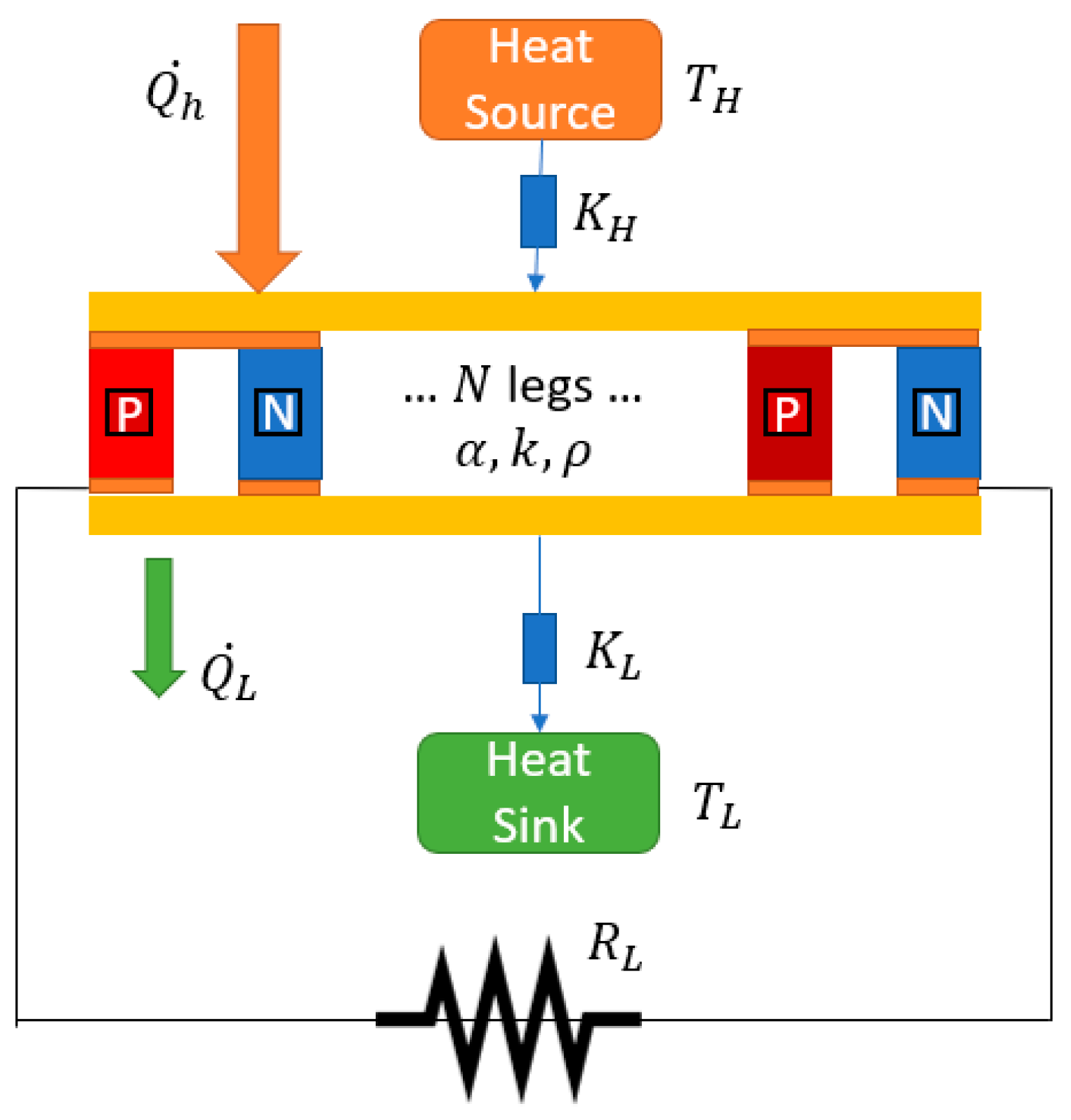
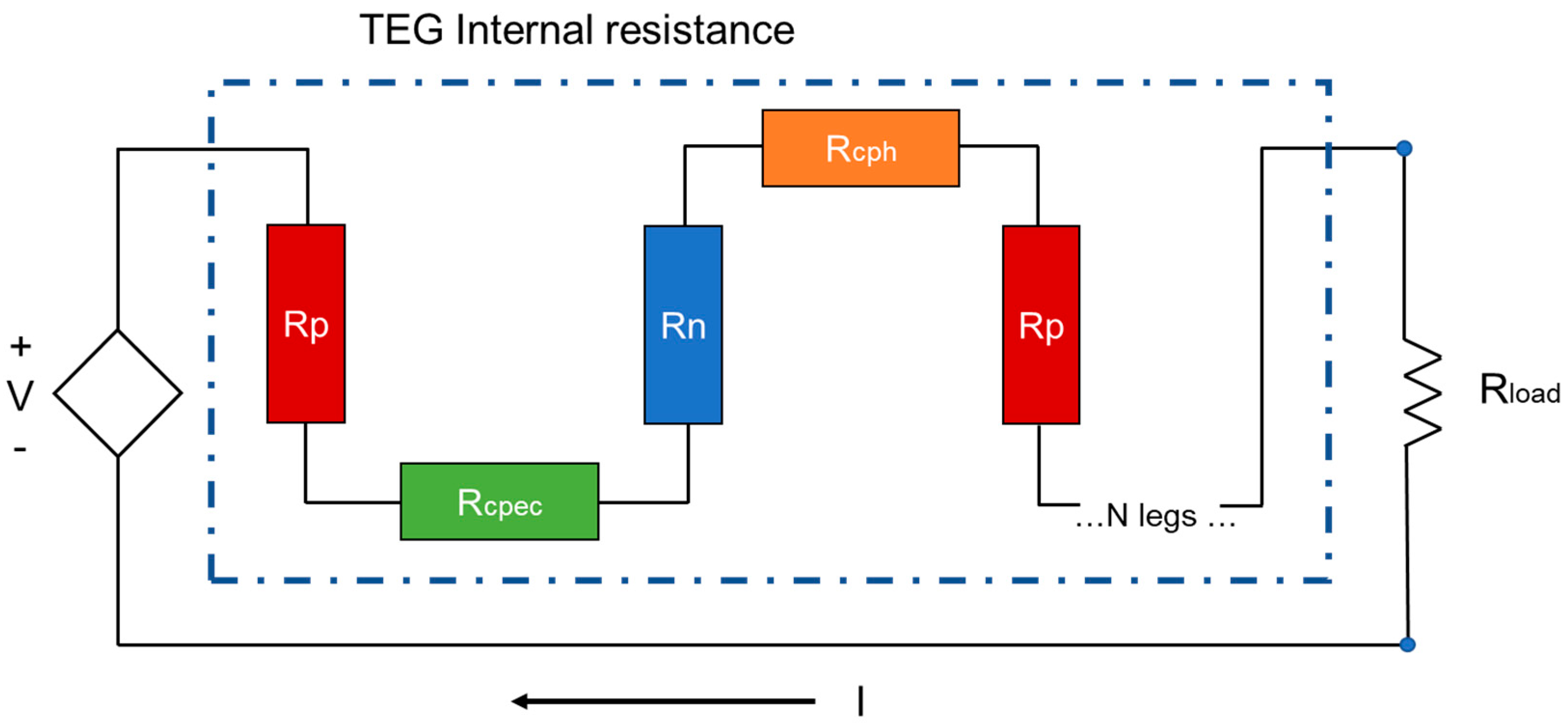
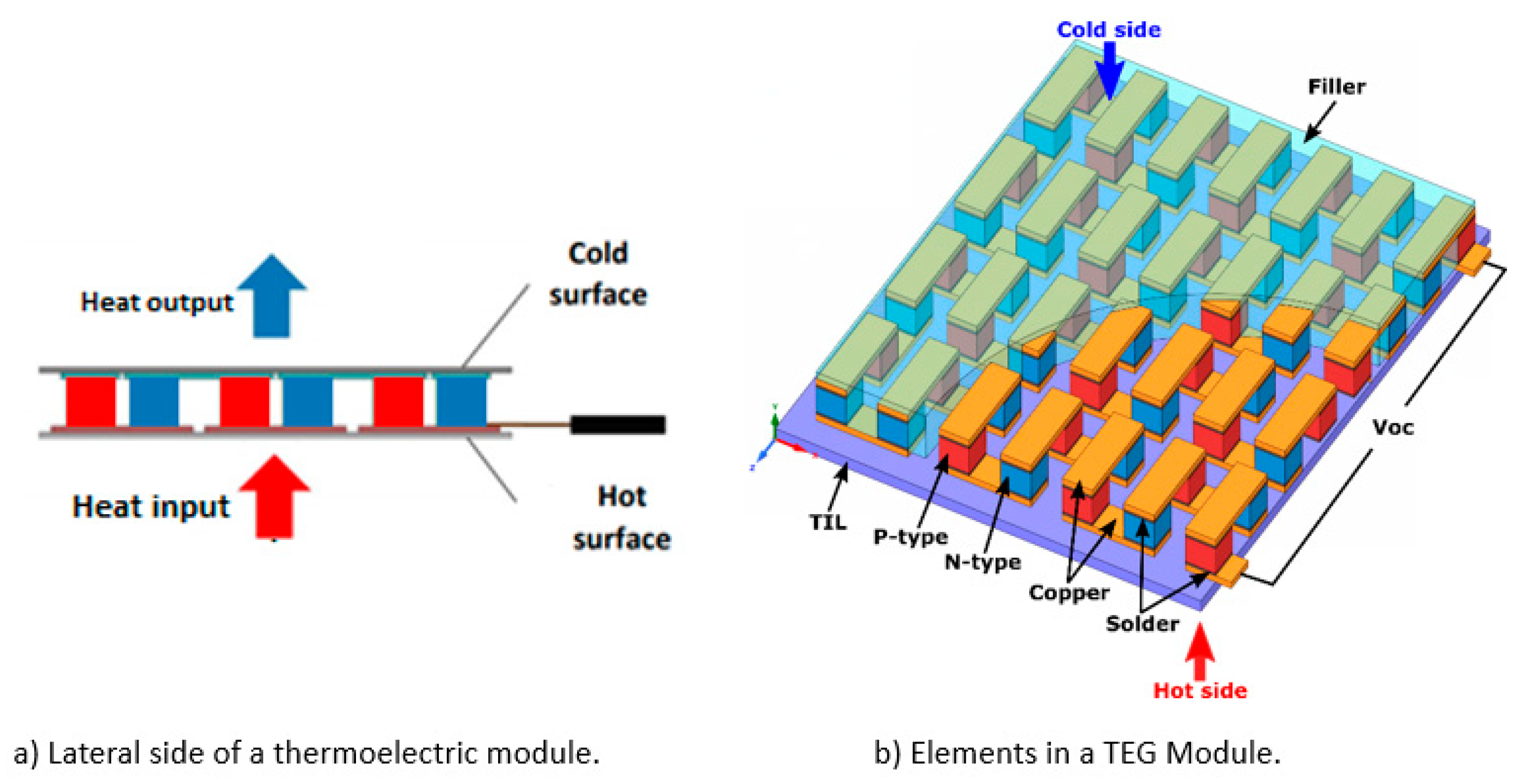
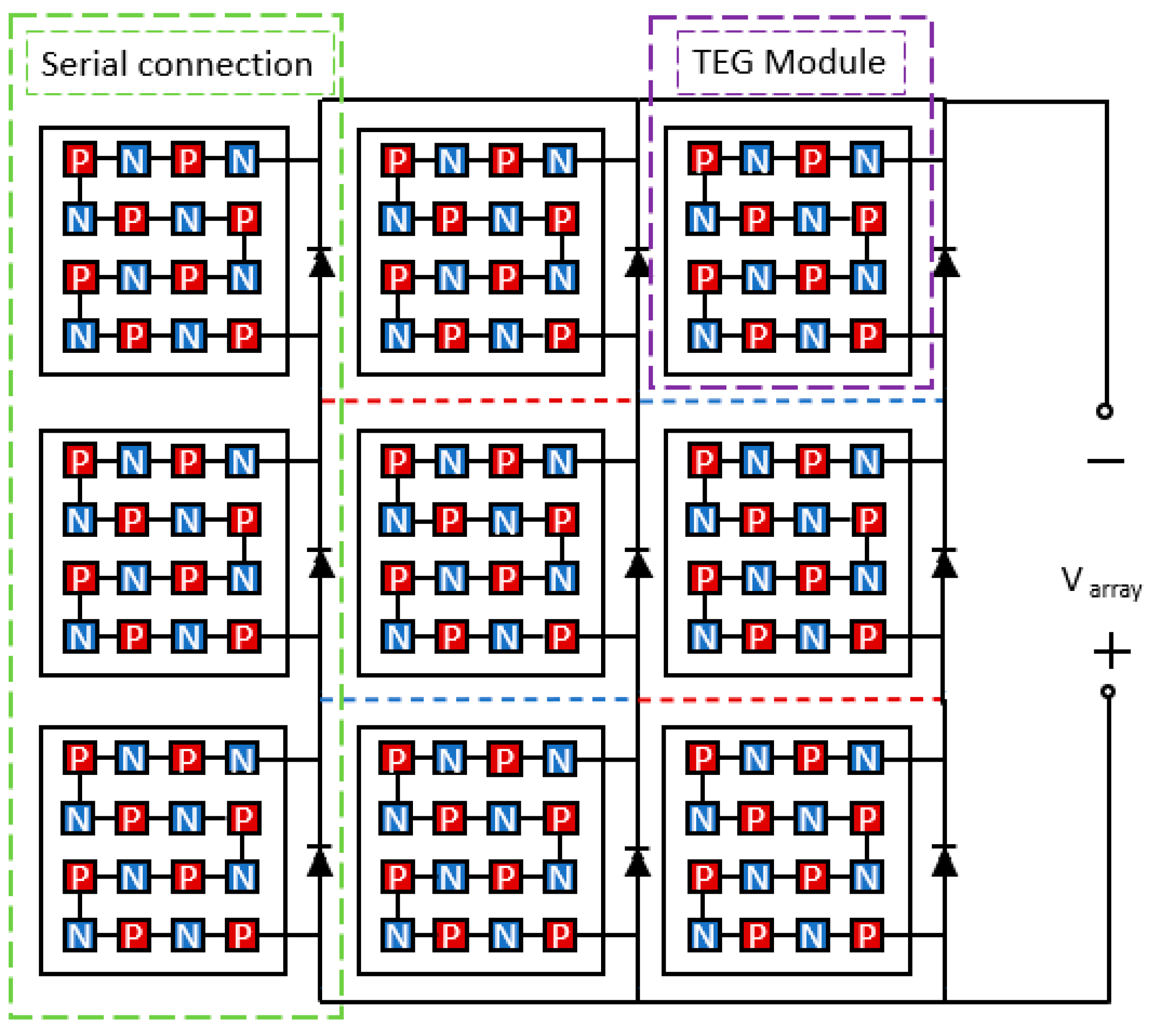
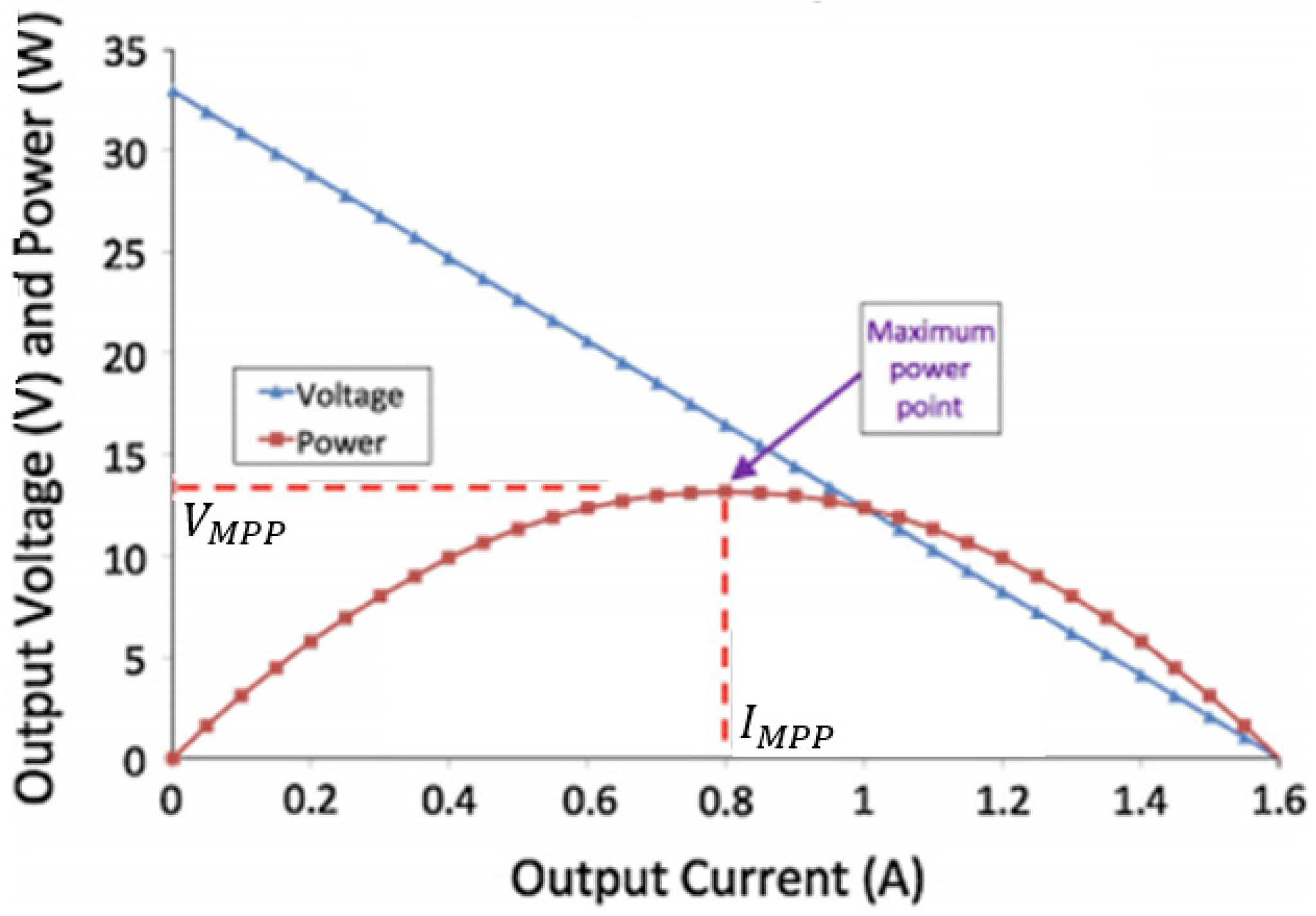
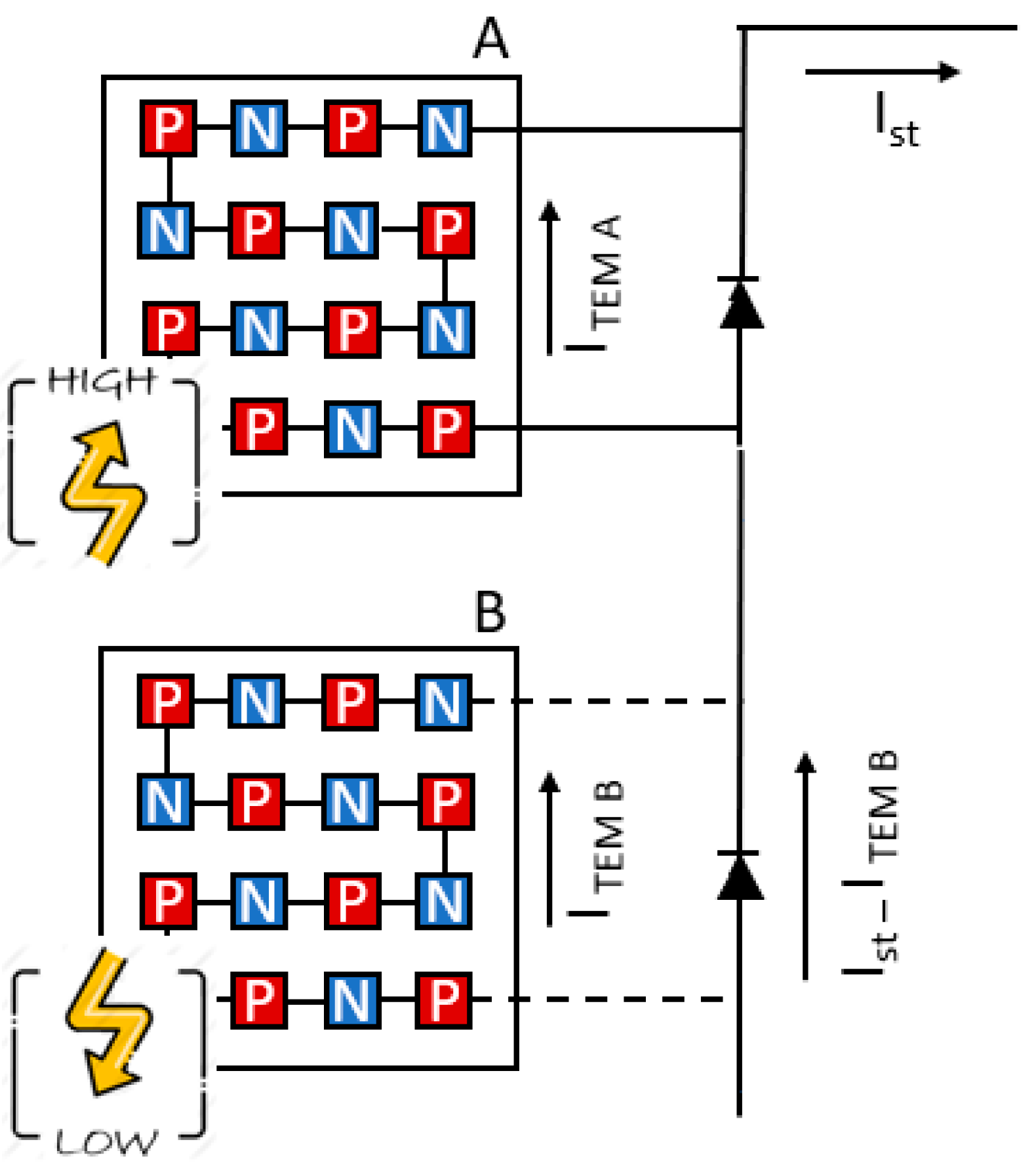

| Material | Max. ZT | Reference |
|---|---|---|
| Nanocrystalline BiSbTe | 1.40 @ 373 K | [64] |
| Bi0.48Sb1.52Te3 | 1.50 @ 390 K | [65] |
| Bi0.5Sb1.5Te3 | 1.30 @ 273 K | [66] |
| Bi0.5Sb1.5Te3 | 1.86 @ 320 K | [67] |
| Polycrystalline BiSbTe alloys with nanodiamond inside | 1.25 @ 323 K | [68] |
| PbTe Tl doped | 1.50 @ 773 K | [69] |
| PbTe Zn n-type doped | 0.80 @ 800 K | [70] |
| AgPbmSbTem+2 | 1.54 @ 723 K | [71] |
| PbTe Na-doped | 1.70 @ 740 K | [72] |
| Na0.03Eu0.03Sn0.02Pb0.92Te | 2.60 @ 800 K | [73] |
| Si95Ge5 with nano Si70Ge30P3 | 1.30 @ 900 K | [74] |
| Si80Ge20-SiO2 nanoinclusions | 0.72 @ 800 K | [75] |
| CoSb3 with nano Yb2O3 | 1.60 @ 835 K | [76] |
| Mg2Si1−xSnx | 1.30 @ 700 K | [77] |
| Mg2Si0.4−xSn0.6Sbx, x = 0.0075 | 1.10 @ 773 K | [78] |
| Hf0.25Zr0.75NiSn0.97Sb0.03 | 1.00 @ 900 K | [79] |
| Zn4Sb3 | 1.35 @ 380 K | [80] |
| Mg3Sb2 Mn doped | 1.85 @ 723 K | [81] |
| Br-doped SnSe single crystal | 2.80 @ 773 K | [63] |
| Polycrystalline SnSe | 2.10 @ 873 K | [82] |
| Cu2Se in phase transition region | 2.40 @ 1000 K | [83] |
Publisher’s Note: MDPI stays neutral with regard to jurisdictional claims in published maps and institutional affiliations. |
© 2022 by the author. Licensee MDPI, Basel, Switzerland. This article is an open access article distributed under the terms and conditions of the Creative Commons Attribution (CC BY) license (https://creativecommons.org/licenses/by/4.0/).
Share and Cite
Sanin-Villa, D. Recent Developments in Thermoelectric Generation: A Review. Sustainability 2022, 14, 16821. https://doi.org/10.3390/su142416821
Sanin-Villa D. Recent Developments in Thermoelectric Generation: A Review. Sustainability. 2022; 14(24):16821. https://doi.org/10.3390/su142416821
Chicago/Turabian StyleSanin-Villa, Daniel. 2022. "Recent Developments in Thermoelectric Generation: A Review" Sustainability 14, no. 24: 16821. https://doi.org/10.3390/su142416821
APA StyleSanin-Villa, D. (2022). Recent Developments in Thermoelectric Generation: A Review. Sustainability, 14(24), 16821. https://doi.org/10.3390/su142416821






